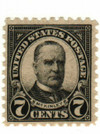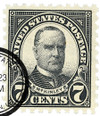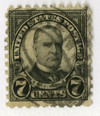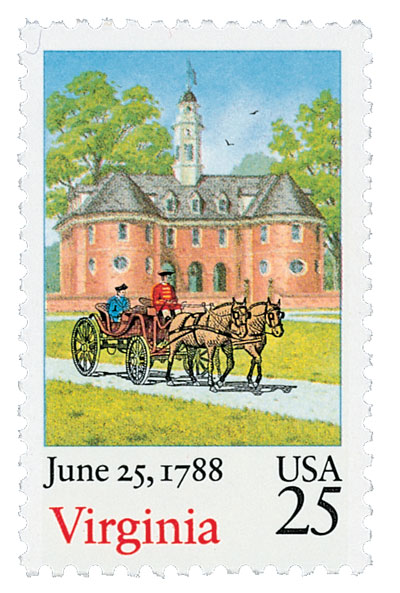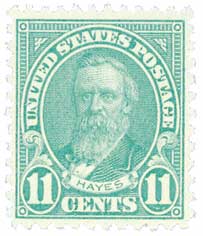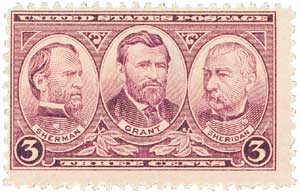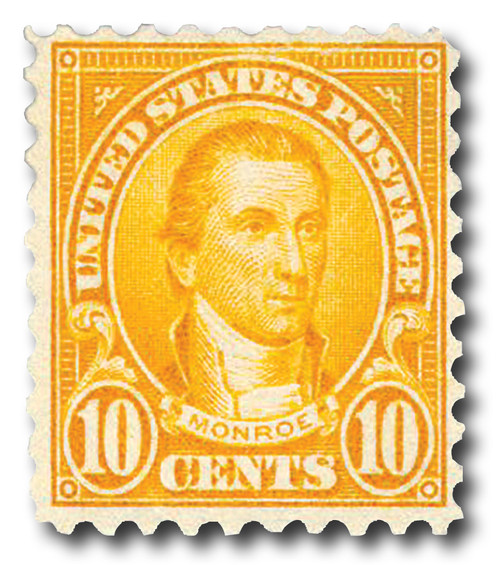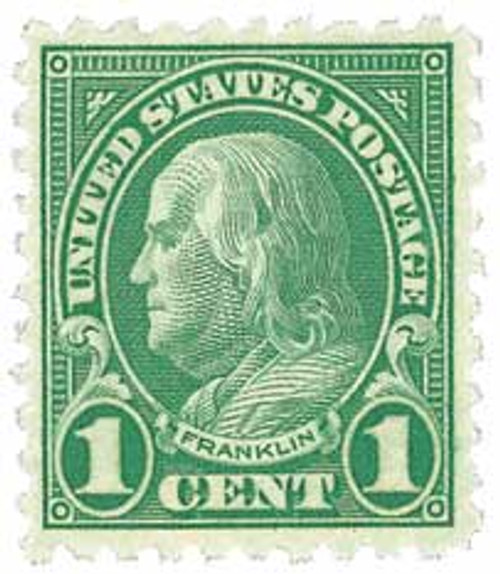
# 588 - 1926 7c McKinley, black
Series of 1923-26 3¢ William McKinley
First City: Washington, D.C. and Niles, OH
Quantity Issued: 80,012,000
Printed by: Bureau of Engraving and Printing
Printing Method: Rotary Press
Perforation: 10
Color: Black
Death Of President McKinley
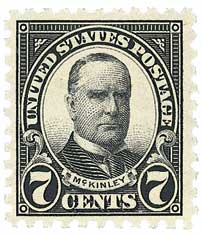
Eight days after being shot by an assassin at the Pan-American Expo, President McKinley died on September 14, 1901.
Born January 29, 1843, in Niles, Ohio, William McKinley was the seventh of eight children. At the age of 10, his family moved to Poland, Ohio.
From an early age, McKinley understood the importance of a good education, studying hard through childhood and as a student at Allegheny College in Meadville, Pennsylvania. However, he fell ill and left after just one term. Upon returning home and regaining his health, McKinley worked as a postal clerk and later a teacher.
Shortly after the Civil War broke out in 1861, McKinley joined the Poland Guards, which later became the 23rd Ohio Infantry. He enjoyed the soldier’s life and often wrote letters to his hometown newspaper praising the army and the Union cause. It was at this time that McKinley first met Rutherford B. Hayes. Impressed with how Hayes led his men, McKinley established a lifelong friendship with him.
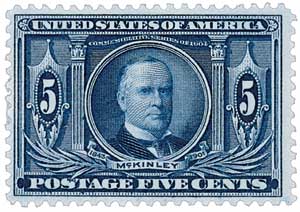
McKinley participated in battles at Carnifex Ferry, Antietam, Kernstown, and Cedar Creek. When the war was over, McKinley’s superiors urged him to join the peacetime army, but he declined, seeking to start a career in law.
Upon returning home, McKinley began studying in a local lawyer’s office before attending Albany Law School. He was admitted to the bar in March 1867 and set up a small office in Canton, Ohio. McKinley’s legal work proved prosperous, as he was soon able to buy an entire block of buildings on Main Street, which provided him with consistent rental income for several decades. In the coming years, McKinley won some high-profile cases and entered politics. He served in Congress and on the House Ways and Means Committee, where he created the McKinley Tariff of 1890.
While still serving in Congress, many people encouraged McKinley to run for governor. In 1891, he won that election by 20,000 votes. As governor of an important swing state, he was a prominent figure in national politics. In this role, he established an arbitration board to settle work disputes and passed a law that instituted fines on employers who fired their workers for being in unions.
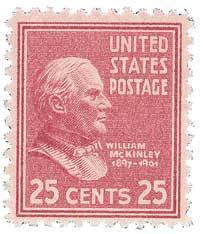
McKinley was among the potential Republican candidates for the 1892 presidential election, but he was forced into a public, neutral role, and encouraged delegates not to vote for him. When Grover Cleveland was elected President, McKinley became the likely candidate for the 1896 election.
While McKinley went about his business as governor, his team traveled the country, building support far ahead of any of his rivals. McKinley also took an unorthodox approach to his campaign. Rather than traveling the nation and delivering speeches, he stayed at home and the people came to him. When they arrived, he delivered speeches on his front porch. As one historian described, “it was, as it turned out, a brilliant strategy. McKinley’s ‘Front Porch Campaign’ became a legend in American political history.” Available to the public every day but Sunday, McKinley received delegations that arrived by railways that offered reduced rates for the trip. In the end, McKinley won 50% of the vote and a large majority in the Electoral College.
Sworn in on March 4, 1897, McKinley delivered a long inaugural address concerning tariff reform, currency issues, and an interest in staying out of foreign affairs. However, he would end up getting America involved in Cuba’s war for independence against Spain, eventually gaining the new territories of Philippines, Guam, Puerto Rico, and Cuba.
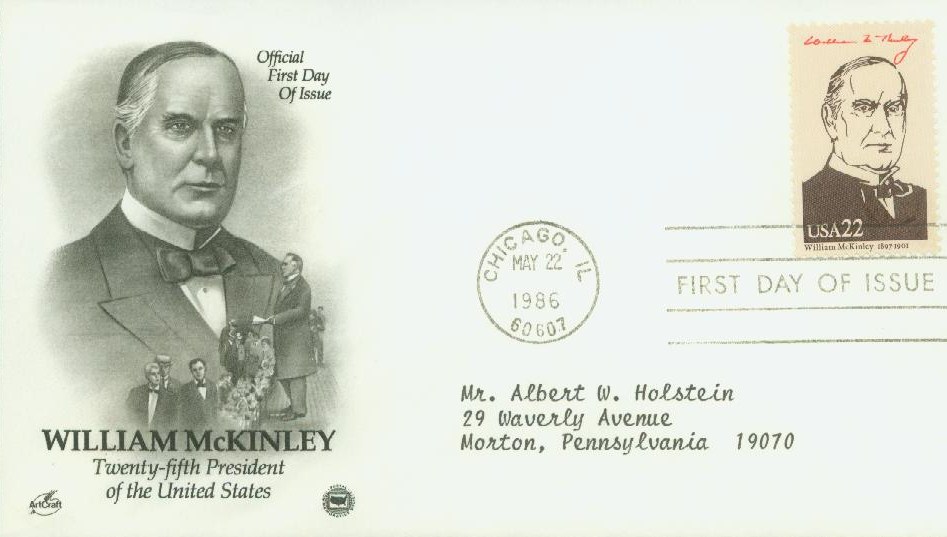
McKinley’s other efforts in foreign policy concerned Hawaii, which had been a republic since seizing power from its royal government in 1893. McKinley supported annexation (acquiring and incorporating as a territory) and pushed Congress to side with him, as he feared inaction would lead to a royalist counter-revolution or a Japanese takeover. The President argued, “We need Hawaii just as much and a good deal more than we did California. It is manifest destiny.” He was successful, signing the annexation legislation in July 1898.
The acquisition of these Pacific possessions increased America’s trade position with China. So McKinley encouraged Congress to establish a commission to look into trade opportunities there and create an “Open Door Policy” that allowed all nations to trade freely with China.
On the domestic front, McKinley faced the issues of tariff reform and free silver. McKinley supported a bill that increased tariffs on wool, sugar, and luxury goods. Though they successfully reached agreements on the issue with France, both India and Britain rejected the proposal. With that failing, McKinley decided to support the gold standard, which turned out well, as gold strikes had increased the monetary supply, causing no need for silver coinage.
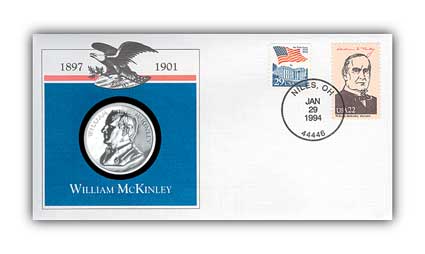
With his popularity assuring the party to renominate him, McKinley sought a new running mate for the 1900 election, as his first Vice President had died the previous year. Theodore Roosevelt had served as Assistant Secretary of the Navy, fought with distinction in Cuba, and was rising through the Republican Party quickly. McKinley campaigned as he had done the last time, from his home, while Roosevelt toured and gave speeches. In November, McKinley won the largest victory of any Republican since 1872.
Following his March inauguration, McKinley and his wife began a national tour. But when Ida fell ill, they postponed the last stop, the Pan-American Exposition in Buffalo, New York, until later in the year. On September 5, McKinley addressed some 50,000 people at the fairgrounds, with Leon Czolgosz among them. Czolgosz was an anarchist who wanted to become a hero. The following day, as the President greeted the public, Czolgosz approached and shot him twice in the chest. Upon being shot, McKinley’s first thoughts were of his wife, telling his aides to be careful how they broke the news to her. He then ordered that the mob of people surrounding Czolgosz leave him be, likely saving his life.
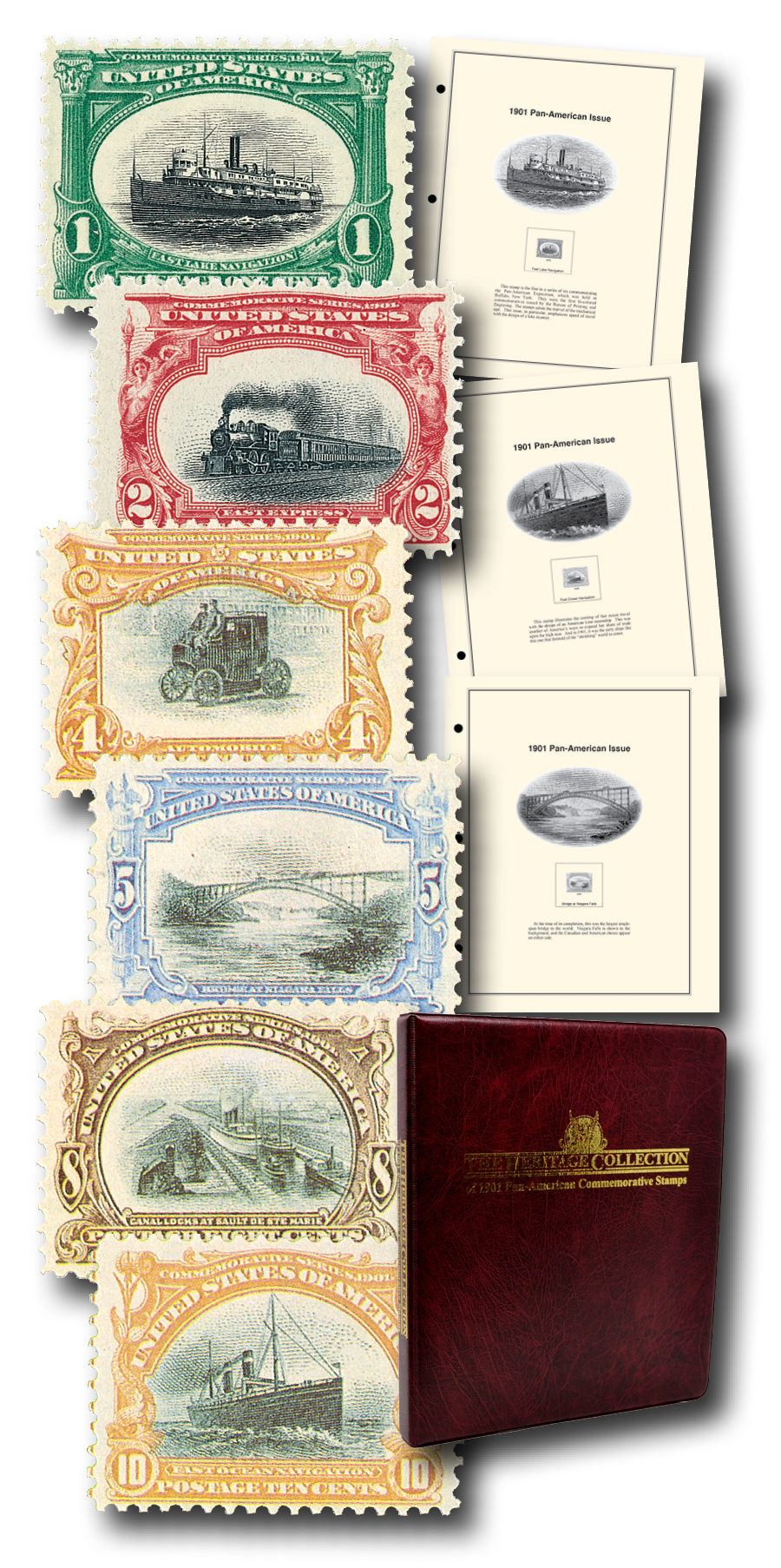
Initially, doctors thought McKinley’s condition was improving. However, they could not tell that he had developed gangrene internally, which was slowly poisoning his blood. Ida sat by his side throughout it all, and when his condition worsened, she cried that she wanted to go with him. He responded, “We are all going… God’s will be done, not ours.” President McKinley died in the early morning hours of September 14, 1901. His assassin was found guilty and later sentenced to death.
According to one historian, “The nation experienced a wave of genuine grief at the news of McKinley’s passing.” At least 200,000 people passed by his casket as it sat in the Capitol Rotunda and a Canton, Ohio, courthouse. McKinley was later interred at a special memorial in his honor, which was already under construction.
Battle Of Cedar Creek
On October 19, 1864, North and South converged at Cedar Creek, Virginia in what would be the last Confederate attempt to invade the North.
After the Battle at Opequon, General Jubal Early retreated with his Southern Army to Waynesboro. Union General Philip Sheridan took advantage of the open Shenandoah Valley and began his scorched-earth campaign. The army burned crops, mills, and factories in order to cut off the South’s source of food and supplies.
Meanwhile, Early was reinforced and decided to go on the attack. He had received a note from commander Robert E. Lee instructing him, “You had better move against [Sheridan] and endeavor to crush him.” Early planned a surprise assault on the Union camp at Cedar Creek, hoping to follow through on Lee’s orders.
Early set his army in place on the evening of October 18, 1864. The first of three columns began their march shortly after darkness fell. Traveling through a narrow path, they arrived to the east of the Union camp undetected. The other two columns started getting into position at about 1:00 a.m. About two hours later, all three units were in place.
The division in the middle was the first to attack at 5:00 a.m. and was quickly joined by the rest. The Union Army was taken by surprise, and many men fled in panic. Captain Henry du Pont was one of the few who kept calm. He turned the artillery on the advancing Confederates and stalled them long enough for the Union to establish a rallying point to the north.
Union General William Emory and his XIX corps were northwest of the initial assault. After hearing the sounds of battle and seeing the retreating troops, he turned his line to face the oncoming Confederates. As a result, he created an opening for another column of the Southern Army at a bridge on Cedar Creek. In spite of this mistake, Emory’s actions slowed the enemy enough to allow time for most units and the supply trains to be withdrawn to safety, and for another corps to prepare a defensive line to the north.
At 7:15, the charging Confederates hit the new defensive line and pushed the Union troops farther back. They joined another federal division, but the Southern attack kept moving forward. One division defended its position on a hill in spite of heavy Confederate artillery fire. This allowed the remaining federal forces to form a line about a mile to the north.
Sheridan had spent the night in Winchester, 12 miles from Cedar Creek. He received reports of gunfire early in the morning but did not feel the news required immediate action. After obtaining additional information, the general saddled his horse and began the trip by 9:00 a.m. As he rode, he noticed the increase in battle sounds and realized his army was retreating.
Series of 1923-26 3¢ William McKinley
First City: Washington, D.C. and Niles, OH
Quantity Issued: 80,012,000
Printed by: Bureau of Engraving and Printing
Printing Method: Rotary Press
Perforation: 10
Color: Black
Death Of President McKinley

Eight days after being shot by an assassin at the Pan-American Expo, President McKinley died on September 14, 1901.
Born January 29, 1843, in Niles, Ohio, William McKinley was the seventh of eight children. At the age of 10, his family moved to Poland, Ohio.
From an early age, McKinley understood the importance of a good education, studying hard through childhood and as a student at Allegheny College in Meadville, Pennsylvania. However, he fell ill and left after just one term. Upon returning home and regaining his health, McKinley worked as a postal clerk and later a teacher.
Shortly after the Civil War broke out in 1861, McKinley joined the Poland Guards, which later became the 23rd Ohio Infantry. He enjoyed the soldier’s life and often wrote letters to his hometown newspaper praising the army and the Union cause. It was at this time that McKinley first met Rutherford B. Hayes. Impressed with how Hayes led his men, McKinley established a lifelong friendship with him.

McKinley participated in battles at Carnifex Ferry, Antietam, Kernstown, and Cedar Creek. When the war was over, McKinley’s superiors urged him to join the peacetime army, but he declined, seeking to start a career in law.
Upon returning home, McKinley began studying in a local lawyer’s office before attending Albany Law School. He was admitted to the bar in March 1867 and set up a small office in Canton, Ohio. McKinley’s legal work proved prosperous, as he was soon able to buy an entire block of buildings on Main Street, which provided him with consistent rental income for several decades. In the coming years, McKinley won some high-profile cases and entered politics. He served in Congress and on the House Ways and Means Committee, where he created the McKinley Tariff of 1890.
While still serving in Congress, many people encouraged McKinley to run for governor. In 1891, he won that election by 20,000 votes. As governor of an important swing state, he was a prominent figure in national politics. In this role, he established an arbitration board to settle work disputes and passed a law that instituted fines on employers who fired their workers for being in unions.

McKinley was among the potential Republican candidates for the 1892 presidential election, but he was forced into a public, neutral role, and encouraged delegates not to vote for him. When Grover Cleveland was elected President, McKinley became the likely candidate for the 1896 election.
While McKinley went about his business as governor, his team traveled the country, building support far ahead of any of his rivals. McKinley also took an unorthodox approach to his campaign. Rather than traveling the nation and delivering speeches, he stayed at home and the people came to him. When they arrived, he delivered speeches on his front porch. As one historian described, “it was, as it turned out, a brilliant strategy. McKinley’s ‘Front Porch Campaign’ became a legend in American political history.” Available to the public every day but Sunday, McKinley received delegations that arrived by railways that offered reduced rates for the trip. In the end, McKinley won 50% of the vote and a large majority in the Electoral College.
Sworn in on March 4, 1897, McKinley delivered a long inaugural address concerning tariff reform, currency issues, and an interest in staying out of foreign affairs. However, he would end up getting America involved in Cuba’s war for independence against Spain, eventually gaining the new territories of Philippines, Guam, Puerto Rico, and Cuba.

McKinley’s other efforts in foreign policy concerned Hawaii, which had been a republic since seizing power from its royal government in 1893. McKinley supported annexation (acquiring and incorporating as a territory) and pushed Congress to side with him, as he feared inaction would lead to a royalist counter-revolution or a Japanese takeover. The President argued, “We need Hawaii just as much and a good deal more than we did California. It is manifest destiny.” He was successful, signing the annexation legislation in July 1898.
The acquisition of these Pacific possessions increased America’s trade position with China. So McKinley encouraged Congress to establish a commission to look into trade opportunities there and create an “Open Door Policy” that allowed all nations to trade freely with China.
On the domestic front, McKinley faced the issues of tariff reform and free silver. McKinley supported a bill that increased tariffs on wool, sugar, and luxury goods. Though they successfully reached agreements on the issue with France, both India and Britain rejected the proposal. With that failing, McKinley decided to support the gold standard, which turned out well, as gold strikes had increased the monetary supply, causing no need for silver coinage.

With his popularity assuring the party to renominate him, McKinley sought a new running mate for the 1900 election, as his first Vice President had died the previous year. Theodore Roosevelt had served as Assistant Secretary of the Navy, fought with distinction in Cuba, and was rising through the Republican Party quickly. McKinley campaigned as he had done the last time, from his home, while Roosevelt toured and gave speeches. In November, McKinley won the largest victory of any Republican since 1872.
Following his March inauguration, McKinley and his wife began a national tour. But when Ida fell ill, they postponed the last stop, the Pan-American Exposition in Buffalo, New York, until later in the year. On September 5, McKinley addressed some 50,000 people at the fairgrounds, with Leon Czolgosz among them. Czolgosz was an anarchist who wanted to become a hero. The following day, as the President greeted the public, Czolgosz approached and shot him twice in the chest. Upon being shot, McKinley’s first thoughts were of his wife, telling his aides to be careful how they broke the news to her. He then ordered that the mob of people surrounding Czolgosz leave him be, likely saving his life.

Initially, doctors thought McKinley’s condition was improving. However, they could not tell that he had developed gangrene internally, which was slowly poisoning his blood. Ida sat by his side throughout it all, and when his condition worsened, she cried that she wanted to go with him. He responded, “We are all going… God’s will be done, not ours.” President McKinley died in the early morning hours of September 14, 1901. His assassin was found guilty and later sentenced to death.
According to one historian, “The nation experienced a wave of genuine grief at the news of McKinley’s passing.” At least 200,000 people passed by his casket as it sat in the Capitol Rotunda and a Canton, Ohio, courthouse. McKinley was later interred at a special memorial in his honor, which was already under construction.
Battle Of Cedar Creek
On October 19, 1864, North and South converged at Cedar Creek, Virginia in what would be the last Confederate attempt to invade the North.
After the Battle at Opequon, General Jubal Early retreated with his Southern Army to Waynesboro. Union General Philip Sheridan took advantage of the open Shenandoah Valley and began his scorched-earth campaign. The army burned crops, mills, and factories in order to cut off the South’s source of food and supplies.
Meanwhile, Early was reinforced and decided to go on the attack. He had received a note from commander Robert E. Lee instructing him, “You had better move against [Sheridan] and endeavor to crush him.” Early planned a surprise assault on the Union camp at Cedar Creek, hoping to follow through on Lee’s orders.
Early set his army in place on the evening of October 18, 1864. The first of three columns began their march shortly after darkness fell. Traveling through a narrow path, they arrived to the east of the Union camp undetected. The other two columns started getting into position at about 1:00 a.m. About two hours later, all three units were in place.
The division in the middle was the first to attack at 5:00 a.m. and was quickly joined by the rest. The Union Army was taken by surprise, and many men fled in panic. Captain Henry du Pont was one of the few who kept calm. He turned the artillery on the advancing Confederates and stalled them long enough for the Union to establish a rallying point to the north.
Union General William Emory and his XIX corps were northwest of the initial assault. After hearing the sounds of battle and seeing the retreating troops, he turned his line to face the oncoming Confederates. As a result, he created an opening for another column of the Southern Army at a bridge on Cedar Creek. In spite of this mistake, Emory’s actions slowed the enemy enough to allow time for most units and the supply trains to be withdrawn to safety, and for another corps to prepare a defensive line to the north.
At 7:15, the charging Confederates hit the new defensive line and pushed the Union troops farther back. They joined another federal division, but the Southern attack kept moving forward. One division defended its position on a hill in spite of heavy Confederate artillery fire. This allowed the remaining federal forces to form a line about a mile to the north.
Sheridan had spent the night in Winchester, 12 miles from Cedar Creek. He received reports of gunfire early in the morning but did not feel the news required immediate action. After obtaining additional information, the general saddled his horse and began the trip by 9:00 a.m. As he rode, he noticed the increase in battle sounds and realized his army was retreating.





